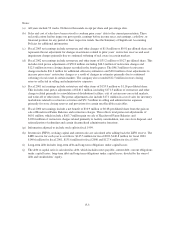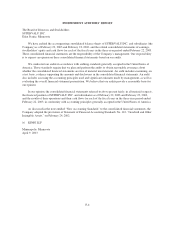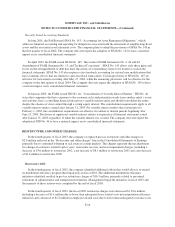Albertsons 2003 Annual Report Download - page 46
Download and view the complete annual report
Please find page 46 of the 2003 Albertsons annual report below. You can navigate through the pages in the report by either clicking on the pages listed below, or by using the keyword search tool below to find specific information within the annual report.SUPERVALU INC. and Subsidiaries
NOTES TO CONSOLIDATED FINANCIAL STATEMENTS—(Continued)
Advertising expenses are also included as a component of cost of sales and are expensed as incurred. The
company recognizes co-operative advertising allowances received from vendors as a reduction of advertising
expense in the period in which the related expense occurs. Advertising expenses before allowances were
$83.9 million, $86.7 million and $103.4 million for fiscal 2003, 2002 and 2001, respectively.
Cash and Cash Equivalents:
The company considers all highly liquid investments with maturities of three months or less at the time of
purchase to be cash equivalents.
Allowances for Losses on Receivables:
Management makes estimates of the uncollectibility of its accounts and notes receivable portfolios. In
determining the adequacy of its allowances, management analyzes the value of the collateral, customer financial
statements, historical collection experience, aging of receivables and other economic and industry factors.
Although risk management practices and methodologies are utilized to determine the adequacy of the allowance,
it is possible that the accuracy of the estimation process could be materially impacted by different judgments as
to collectibility based on the information considered and further deterioration of accounts.
Reserves for Closed Properties:
The company maintains reserves for estimated losses on retail stores, distribution warehouses and other
properties that are no longer being utilized in current operations. Calculating the estimated losses requires
significant judgments and estimates to be made by management. The company’s reserves for closed properties
could be materially affected by factors such as the extent of interested buyers, its ability to secure subleases, the
creditworthiness of sublessees and the company’s success at negotiating early termination agreements with
lessors. These factors are significantly dependent on the general health of the economy and resultant demand for
commercial property. While management believes the current estimates of reserves on closed properties are
adequate, it is possible that continued weakness in the real estate market could cause changes in the company’s
assumptions and may require additional reserves to be recorded.
LIFO and Retail Inventory Method:
Inventories are stated at the lower of cost or market. For a significant portion of the company’s inventory,
cost is determined through use of the last-in, first-out (LIFO) method for food distribution or the retail LIFO
method, as applicable. Under the retail LIFO method, otherwise referred to as the retail inventory method (RIM),
the valuation of inventories are at cost and the resulting gross margins are calculated by applying a calculated
cost-to-retail ratio to the retail value of inventories. Market is replacement value. The company utilized LIFO or
the retail LIFO method to value approximately 70.5 percent and 69.8 percent of the company’s consolidated
inventories for fiscal 2003 and 2002, respectively. The first-in, first-out method (FIFO) is used to determine cost
for some of the remaining highly consumable inventories. If the FIFO method had been used to determine cost of
inventories for which the LIFO method is used, the company’s inventories would have been higher by
approximately $145.5 million at February 22, 2003 and $140.8 million at February 23, 2002.
Reserves for Self Insurance:
The company is primarily self-insured for workers’ compensation and general and automobile liability
costs. It is the company’s policy to record its self insurance liabilities based on claims filed and an estimate of
F-11
























